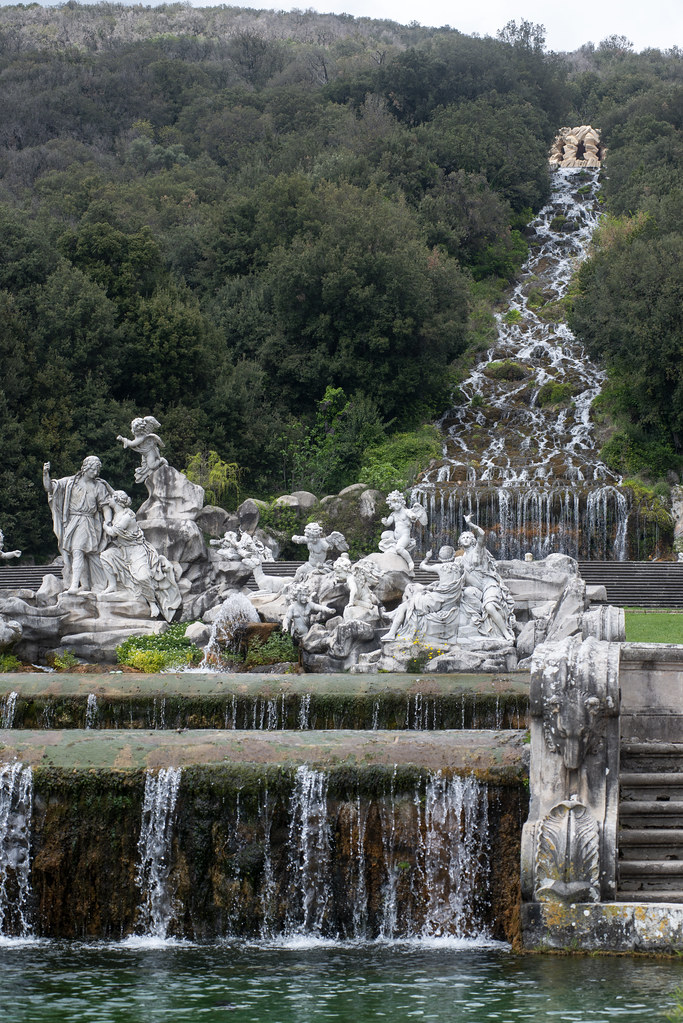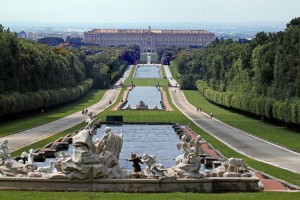cascata (I)
cascada (S)
Wasserfall (G)
cachoeira (P)
waterfall (E)
reggia di caserta, italy

For this post, we had to start with a picture. This is the waterfall which provides water to the fountains of the Reggia di Caserta or Caserta Palace, north of Naples, Italy, and indeed, to the palace itself. The waterfall is fed by the Caroline Aqueduct, built in the 18th century to supply water to the city of Naples. The aqueduct and all of the water features at the Reggia di Caserta were designed by Luigi Vanvitelli, a native Neapolitan and son of Dutch painter Gaspar Van Wittel. Vanvitelli also worked on the Trevi Fountain in Rome (of Three Coins in a Fountain fame), St. Peter’s Basilica, and the Royal Palace of Naples, but Reggia di Caserta is his masterpiece. The waterfall flows into the Fountain of Diana and Actaeon, which is at the end of two long, parallel avenues which stretch between the waterfall and the palace. There are four other fountains along the avenues which descend down to the palace. The palace’s parks cover 300 acres. Another picture, please.

So, this picture is looking from the waterfall towards the palace itself, a distance of three kilometers or about 1.9 miles. Yes, just say it, “Oh la vache or holy cow, it rivals Versailles.” Well, considering the Bourbon King who built it, Charles VII of Naples (later Charles III of Spain) was the grandson of Louis XIV, the French king who built Versailles, there may have been some family rivalry involved. Charles VII was looking to build a palace away from Naples, which was subject to attack from the sea as well as from the east by that most famous of volcanoes, Mount Vesuvius. He sent Vanvitelli to make a survey of the land around Caserta, 25 kilometers (15.5 miles) from Naples and choose Vanvitelli’s design for the palace.
Construction started in 1752 but slowed down in 1759 after Charles had to go back to Spain to become King of Spain. The palace was built but not furnished when Vanvitelli died in 1773. Its decoration continued under his son Carlo. Throw in a lot of political strife, quite a bit of which was due to Napoleon and too complicated to discuss here, and the palace wasn’t truly completed until 1845.
Well, it took almost 100 years but what a palace it is. It’s been a UNESCO site since 1997. By volume, it is the largest palace in the world. It is five stories tall and 810 feet wide. 45,00 square meters of space. It is rectangular with four orthogonal arms which create four inner courtyards. It has 1400 rooms, of which 40 are which are monumental rooms, built to host royalty and famous guests. And, while the outside is fairly plain, the inside is Italian Baroque and Neo Classical, some of the most beautiful rooms you’ll ever see. After being used by the monarchs of the Kingdom of the Two Sicilies until 1861, the palace passed to the House of Savoy after Italian unification. In 1919, King Victor Emmanuel III donated it to the Italian state.
The Italian state used the palace as the home of the Italian Air Force Academy from 1926 to 1943. (What a spectacular spot to go to school.) Italy and Germany started World War II on the same side. But, with the Italians defeated in northern Africa and the Allies in Sicily; the Italian leader Benito Mussolini deposed and his government in collapse; on September 8, 1943, General Dwight D. Eisenhower announced that Italy had surrendered to the Allies. The next day, Allied troops began landing in Salerno, south of Naples, in Operation Avalanche. The Germans vowed to continue fighting, now occupying their former ally, and launched Operation Axis. Fighting between the Allies and Germany in Italy would continue until 1945. Prior to the Italian surrender, in August 1943, the palace complex was bombed by the Allies and parts of it, in particular, the Palantine chapel, were damaged, but not destroyed. The palace continued to make history. As the Allies made their way north, the palace served as the Allied command headquarters. And, on April 29, 1945, the written agreement (Surrender of Caserta) that formalized the surrender of German forces in Italy, was signed at the Royal Palace of Caserta. For some interesting photos taken of the palace during the war and a video of the surrender, click here.
This history of Reggia di Caserta illustrates a question highlighted in the book (and later movie), The Monuments Men, by Robert M. Edsel, about a group of soldiers during World War II tasked with protecting cultural treasures in the path of destruction and searching for those that had been plundered, stolen or had been secreted for safe keeping. Part of the palace was bombed in order to advance the cause of war, with a loss of art and culture to both the Italian people and the world at large. What should take priority? The question was being asked by political and military men. For another post, is a discussion of Montecassino Abbey, located on a mountainous site, which was eventually destroyed in early 1944, after much discussion, by the Allies trying to oust the Germans from its heights. But its destruction helped shape the guidance issued by Dwight D. Eisenhower, the Supreme Allied Commander, eleven days before the D-Day invasion on June 6, 1944:
Shortly we will be fighting our way across the Continent of Europe in battles designed to preserve our civilization. Inevitably, in the path of our advance will be found historical monuments and cultural centers which symbolize to the world all that we are fighting to preserve.
It is the responsibility of every commander to protect and respect these symbols whenever possible.
In some circumstances the success of the military operation may be prejudiced in our reluctance to destroy these revered objects. Then, as at Cassino, where the enemy relied on our emotional attachments to shield his defense, the lives of our men are paramount. So, where military necessity dictates, commanders may order the required action even though it involves destruction to some honored site.
But there are many circumstances in which damage and destruction are not necessary and cannot be justified. In such cases, through some exercise of restraint and discipline, commanders will preserve centers and objects of historical and cultural significance. Civil Affairs Staffs at higher echelons will advise commanders of the locations of historical monuments of this type, both in advance of the frontlines and in occupied areas. This information, together with the necessary instruction, will be passed down through command channels to all echelons.
It is impossible to know what treasures this guidance may have saved.